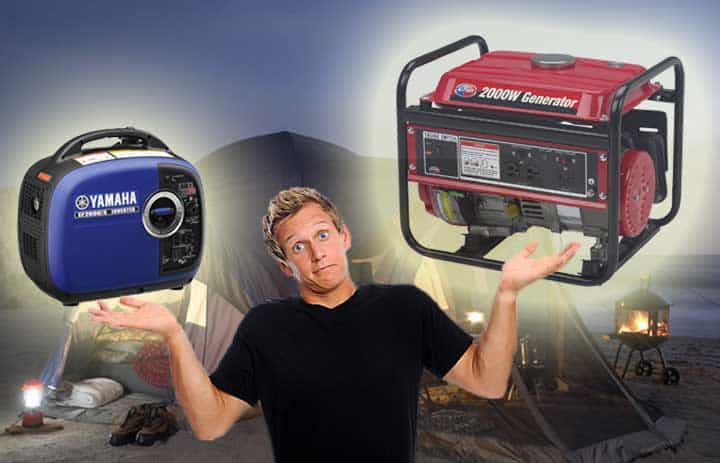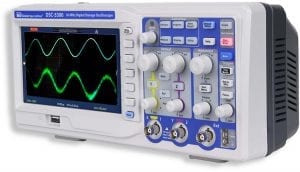Conventional Generators vs Inverter Generators
What’s the difference… and which is better (for you!)?

Because of the similarity of the terms and the fact that many people use them almost interchangeably, there seems to be quite a bit of confusion among consumers as to what the difference is between a generator, an inverter and an inverter generator. And once you know what the difference is, which one is better? We’ll try to provide succinct, informative answers to these questions here, so read on!
Conventional Generators
Conventional generators have been around for quite a while, and the basic concept behind them has remained essentially unchanged. They consist of an energy source, usually a fossil fuel such as diesel, propane or gasoline, which powers a motor attached to an alternator that produces electricity. The motor must run at a constant speed (usually 3600 rpm) to produce the standard current that most household uses require (in the U.S., typically 120 Volts AC @ 60 Hertz). If the engine’s rpm fluctuates, so will the frequency (Hertz) of the electrical output.
Inverters
A traditional inverter draws power from a DC source (typically a comparatively fixed source, like a car battery or a solar panel), and uses electronic circuitry to “invert” the DC power into AC power. The converted AC can be at any required voltage and frequency with the use of appropriate equipment, but for consumer-level applications in the U.S., the most common combination is probably taking the 12VDC power from car, boat or RV batteries and making it into the 120VAC power required for most everyday uses.
Inverter Generators
Inverter generators are a relatively recent development, made possible by advanced electronic circuitry and high-tech magnets. These are generally 3-phase generators that output AC current like most traditional generators, but that current is then converted to DC, and then “inverted” back to clean AC power that maintains a single phase, pure sine wave at the required voltage and frequency.
Because these units employ the technologies used by both generators and inverters, they are perhaps most correctly called “inverter generators” but since people tend to simplify terminology, “inverter generator” often gets clipped, sometimes to “inverter” and sometimes to “generator” which leads to confusion as to what is what and which one is being discussed. In spite of this lack of clarity, both terms are commonly used to refer to inverter generators, even by the manufacturers. (As a side note, it should be mentioned that Inverter Generators are also sometimes called “I-Generators”, but seriously, don’t we already have enough “I-things” in this world!)
Unfortunately, we won’t be able to settle this debate over nomenclature here, but you should be aware of the terminology when you’re dealing with the topic of consumer-level electrical power generation.
So What’s the Difference Between Conventional Generators and Inverter Generators?
First, we’ll leave traditional plain old inverters aside, as they are not suitable for most applications you probably have in mind when you are looking for a “generator”. If you want to charge your phone or a laptop in your car or truck, a regular inverter is what you need. But if you need to generate power, rather than convert your vehicle’s DC into AC, then the plain old inverter isn’t going to do the job. You’ll need either a conventional generator or an inverter generator.
Here’s a quick video overview of the differences between conventional generators and inverter generators.
So as the video shows, there are a number of important differences between these two categories. To boil it down, traditional generators tend to be bigger/heavier and noisier. The power they produce is “dirtier” but they are substantially more affordable. Inverter generators, on the other hand, tend to be more portable and quieter. They produce much “cleaner” power, but they’ll take a bigger bite out of your wallet.
OK – So Which is Better?
So what’s better – conventional, tried and true generators, or the newer inverter-style generators? Well, as is often the case, there is not just one answer to this question. The type of unit that is best for you will depend on a number of factors, from max output to what you want to do with the power you generate. We’ll take a look at what we think are the 8 most important buying considerations and how each type of generator stacks up for each of them.
1. Size / Weight / Portability
Many of the new inverter generators are surprisingly small and lightweight for the electrical generation punch that they pack. Sizes of just a couple of cubic feet and weights in the 30 to 50 pound range are not uncommon today. This means that they are a breeze to transport and store, and while you might not want to take one on a hike, they will easily fit in your car, boat or RV. In contrast, many conventional generators are heavy and bulky, often requiring a substantial metal frame and wheels. While they are technically portable in that they can be moved from place to place, they lack the convenience factor of the smaller, lighter inverters.
2. Fuel Efficiency / Run Times
Conventional g enerators are often designed simply to get a certain amount of power where it is needed, and to keep the power on. Factors like the size of the unit have not been a major consideration. This has meant that conventional designs can often accommodate sizable fuel tanks, with the obvious result being relatively long run times. Inverters on the other hand are frequently designed from the get-go to be compact and lightweight. This means they can’t have a big, heavy fuel tank. The obvious result of a more limited fuel capacity is shorter run times. Nevertheless, inverters’ fuel-efficient engines and their ability to adjust engine speed to the load at hand (conventional units generally run at 3600 rpm regardless of the load) means they make better use of the fuel they do have (savings can be as much as 40%), and their run times of 8 to 10 hours and more are generally more than adequate for their applications.
enerators are often designed simply to get a certain amount of power where it is needed, and to keep the power on. Factors like the size of the unit have not been a major consideration. This has meant that conventional designs can often accommodate sizable fuel tanks, with the obvious result being relatively long run times. Inverters on the other hand are frequently designed from the get-go to be compact and lightweight. This means they can’t have a big, heavy fuel tank. The obvious result of a more limited fuel capacity is shorter run times. Nevertheless, inverters’ fuel-efficient engines and their ability to adjust engine speed to the load at hand (conventional units generally run at 3600 rpm regardless of the load) means they make better use of the fuel they do have (savings can be as much as 40%), and their run times of 8 to 10 hours and more are generally more than adequate for their applications.
Also, because they are more fuel-efficient, inverter generators use less gasoline, saving you money and helping to reduce exhaust emissions. Note that the Yamaha EF2000iSv2 is fully compliant with all EPA guidelines, as well as the more stringent CARB (California Air Resources Board) regulations.
3. Noise: Can Ya Hear Me Now?
The issue of noise is one that truly separates the two categories of generators. Inverter generators are often designed from the ground up to be comparatively quiet. Quieter engines, special mufflers, and sound-dampening technology are used to reduce noise to amazingly low levels. In addition, conventional models have to run at a constant speed (typically 3600 rpm) in order to produce electricity with the desired characteristics (120VAC @ 60Hz in most cases). If the engine speed varies, the qualities of the power generated also change, which is clearly undesirable, so the engine speed must remain constant, and with that comes the constant noise of a generator running at full speed. Inverters, on the other hand, can adjust the electrical characteristics of the power produced using microprocessors and special electronics. This means that the engine can throttle back when the load is light, saving fuel and substantially reducing noise. The Yamaha EF2000iSv2, for example, produces just 51.5 decibels of sound when running at ¼ load (about the same as a quiet office), and only about 60 decibels when running at full load (about the same as a normal conversation). In contrast, many conventional generators are rated at 65 to 75 decibels – the same range that includes street traffic, a noisy restaurant or a loud barking dog!
4. Max Power Output
Conventional generators come in just about any size you want, from 500 watts up to 50,000 watts and higher. Inverter generators’ focus on quiet operation and portability means that their maximum output possibilities are more limited – they are mainly available in 1000 to 4000 watt models.
5. Quality of Power Produced
A conventional generator is nothing more than an engine connected to an alternator and run at a speed that produces the desired AC frequency, regardless of the load on it (as the load increases the engine throttles up to keep the engine speed the same). The output of the alternator is connected directly to the load, without any processing.
 With an inverter generator, the engine is connected to an efficient alternator, which produces AC electricity, just like a conventional generator. But then a rectifier is used to convert the AC power to DC and capacitors are used to smooth it out to a certain degree. The DC power is then “inverted” back into clean AC power of the desired frequency and voltage (e.g., 110-120VAC @ 60Hz).
With an inverter generator, the engine is connected to an efficient alternator, which produces AC electricity, just like a conventional generator. But then a rectifier is used to convert the AC power to DC and capacitors are used to smooth it out to a certain degree. The DC power is then “inverted” back into clean AC power of the desired frequency and voltage (e.g., 110-120VAC @ 60Hz).
The output is very well regulated and this system produces consistent power characteristics independent of the engine speed. The result is much “cleaner” power (i.e., “pure sine waves”, as shown by the top wave in the image above) than is possible with a conventional generator. Inverters will produce essentially the same quality of clean electricity that you typically get from your electric company.
Why is this important? Well, more and more products today use some form of microprocessor. Not just your computer, but also your phones, TVs, game consoles, printers, DVD players, and even kitchen appliances and power tools now use sophisticated electronic circuitry. And all these microprocessors are very sensitive to the quality of the electricity they use. Using power that isn’t “clean” can make these devices malfunction, or even damage them. So any application that uses sensitive electronics – and that includes a lot more things than you might think – will likely benefit substantially from the cleaner power provided by an inverter generator.
6. Parallel Operation
Many inverters, like the Yamaha EF2000iSv2 generator, can be paired with another identical unit to double your power capacity. This type of parallel capability means you can use two smaller, lighter generators to provide the same wattage and amperage of one much larger generator – without sacrificing all the benefits of the smaller, lighter, quieter, more portable inverter units. Conventional units simply can’t offer this feature. Note that you will need a special cable to connect your generators to take advantage of the combined power output, which is available separately, or, in some cases, is included when you buy a pair of generators at the same time. Check out Yamaha’s TwinTech and Sidewinder cables, or our Combos page for details.
7. Simplicity of Design and Construction
While there is no evidence that inverter generators are overly complex or that they have a higher failure rate than conventional types, it is true that some people see simplicity of design and construction as an advantage for a conventional design. Since conventional models are basically just a motor with an alternator attached, they are fundamentally simple machines – simple to run, maintain and repair. The motor just cranks along at a standard rpm, usually 3600, and there are not usually any complicated controls, electronics or other things to go wrong. That said, inverter generators have been around for a number of years now. The technologies they use are generally well-tested, and inverters have not demonstrated any significant reliability issues in comparison with traditional designs. So whether simplicity in design and construction is an advantage or a negligible issue is really just a matter of personal preference.
8. Price
 Real estate may be all about location, location, location, but just about everything else in life comes down to price, price, price. And so it is with generators. With all their advantages, inverter generators must have a downside, right? Well, if there is one, it is probably cost – an inverter generator simply costs more than a conventional one with a similar, or even a higher, power rating. So the benefits – portability and convenience, fuel-efficiency, much lower noise levels, and so on – do come at a price. In deciding which type of generator is right for you, you’ll have to look at your applications and your budget. Only you can decide if the higher price tag is worth the extra features and benefits. But judging from the soaring popularity of inverter generators, and the excellent reviews that models like the Yamaha EF2000iSv2 consistently receive, it is clear that more and more people are deciding that the advantages are definitely worth the higher price tag.
Real estate may be all about location, location, location, but just about everything else in life comes down to price, price, price. And so it is with generators. With all their advantages, inverter generators must have a downside, right? Well, if there is one, it is probably cost – an inverter generator simply costs more than a conventional one with a similar, or even a higher, power rating. So the benefits – portability and convenience, fuel-efficiency, much lower noise levels, and so on – do come at a price. In deciding which type of generator is right for you, you’ll have to look at your applications and your budget. Only you can decide if the higher price tag is worth the extra features and benefits. But judging from the soaring popularity of inverter generators, and the excellent reviews that models like the Yamaha EF2000iSv2 consistently receive, it is clear that more and more people are deciding that the advantages are definitely worth the higher price tag.
So Which One Wins – the Conventional Generator or the Inverter Generator?
It really depends on your priorities as a buyer. If all you need is to get some power someplace where there isn’t any, and you are more concerned with dollars than decibels, a conventional unit is probably the way to go for you. But if you’re like the growing number of people who are finding that the convenience, clean power, quiet operation and portability provided by modern inverters offer better overall value for the money, then you’ll be much happier going with an inverter generator like the Yamaha EF2000iSv2.